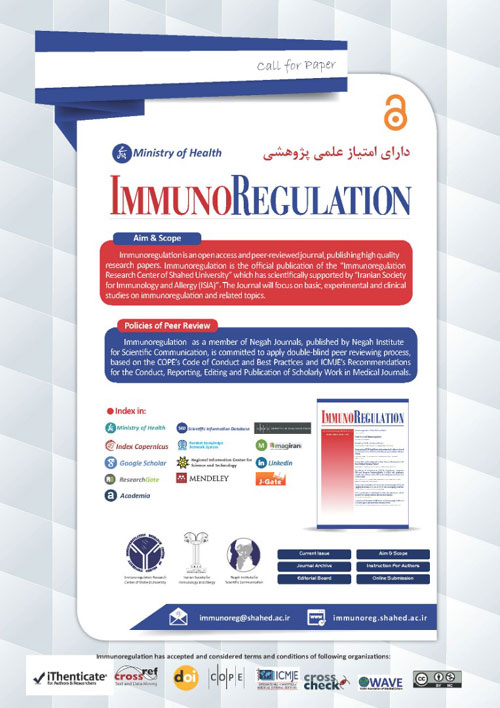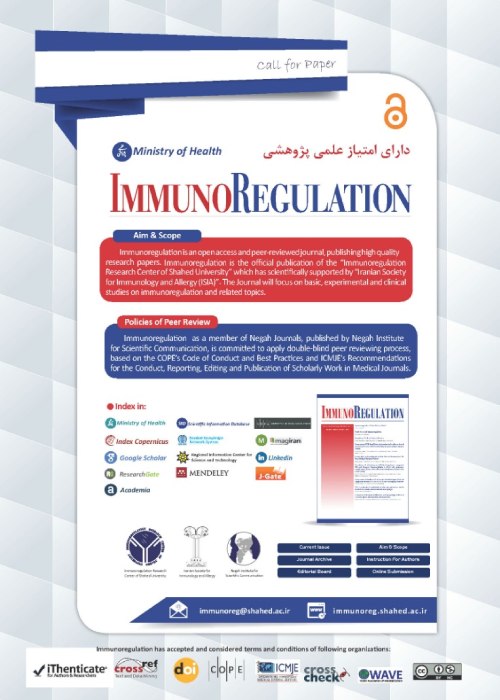فهرست مطالب

Immunoregulation
Volume:4 Issue: 2, Winter 2021
- تاریخ انتشار: 1401/03/19
- تعداد عناوین: 8
-
-
Pages 69-72Severe Acute Respiratory Syndrome Coronavirus-2 (SARS-CoV-2) rapidly spread worldwide. The exact mechanisms involved in the pathogenesis of Coronavirus Disease 2019 (COVID-19) are not fully understood. In addition to classical treatment, herbal medicine may effectively manage COVID-19 symptoms and supportive therapy. Scrophularia striata Boiss is a perennial herbaceous plant with immunomodulatory and anti-inflammatory properties. The extract of S. striata Boiss has revealed immunomodulatory effects on reducing T helper 2 (Th2) cytokines, including IL-4 and IL-5, that may be used to manage allergic diseases and asthma. Scrophularia striata Boiss reduces IL-4, and IL-5 may alleviate allergic diseases and asthma. The ethyl acetate extract of S. striata Boiss inhibits the production of IL-1β, TNF-α, and PGE2. Quercetin inhibits proinflammatory mediators while increasing anti-inflammatory mediators. Ethanolic extract of S. striata can significantly reduce NO production in the isolated mouse peritoneal macrophages. Moreover, S. striata Boiss has 3 essential flavonoids: quercetin, isorhamnetin-3-O-rutinoside, and nepitrin. Of them, quercetin inhibits TNF-α, IL-1β, IL-6, PGE2, COX-2, and NO, whereas increases anti-inflammatory cytokines. Therefore, S. striata Boiss is recommended for clinical trial studies in patients with COVID-19 and other viral diseases.Keywords: COVID-19, SARS-CoV-2, Scrophularia striata Boiss, Cytokine, Quercetin
-
Pages 73-81Background
Emphasis on substitutional medications with the elevated bacterial resistance to current antibiotics is pivotal. We evaluated the antibacterial effect of AK2 by Minimum Bactericidal Concentration (MBC) and Minimum inhibitory Concentration (MIC) and its impact on macrophage responses in 17 strains of pathogenic bacteria. The gene expression of macrophage’s cytokines was evaluated. Accordingly, the bioinformatic assessment predicted this peptide’s physicochemical characteristics, behavior, and structures. The present study aimed to assess the antibacterial effect of AK2 peptides on Macrophage responses.
Materials and MethodsCytotoxicity level was assessed by MTT assay on the HeLa cell line. The hemolytic activity of peptides on red blood cells was evaluated. The Griess assay was performed to assess the amount of macrophage nitric oxide production. The real-time PCR method measured the iNOS, IFN-γ, and TNF-α gene expression in isolated macrophages.
ResultsPeptide concentrations (13-60 µg/mL) were observed as the MBC and MIC value results for various bacteria. No remarkable cytotoxicity was observed at 30 and 60 µg/ml concentrations after 24h. iNOS, IFN-γ, and TNF-α gene expression were upregulated. There was also a higher secretion of nitric oxide in 48 hour-culture of the cell line with peptide. Great antibacterial activity was observed in some bacterial strains, particularly B. melitensis.
ConclusionAK2 peptides display suitable antibacterial activity with negligible toxicity for host cells. This peptide could also stimulate macrophage responses through nitric oxide production and gene expression in proinflammatory cytokines.
Keywords: Antimicrobial peptide, Macrophage responses, Nitric oxide, Proinflammatory cytokines -
Pages 83-90Background
Regulatory T Cells (Treg) are the subgroups of lymphocytes that control inflammatory responses and regulate homeostasis processes through cellular contact and the secretion of soluble agents. We investigated the frequency of Treg in peripheral blood of sulfur mustard exposed patients with CD4, CD25, CD127, FOXP3, and CD45RA markers, compared with healthy individuals and the correlation between frequency of these cells and long-term pulmonary complications.
Materials and MethodsIn total, 12 sulfur mustard exposed patients and 12 healthy volunteers were invited. Clinical inspections of both groups were performed by pulmonary specialists and spyrometric evaluation that pulmonary function test operators conducted. After the isolation of peripheral blood mononuclear cells, the frequency of Treg cells was determined by flowcytometry.
ResultsThe frequency of Treg cells was not significantly different in those exposed to sulfur mustard. Furthermore, there was no significant correlation between spyrometric parameters and the frequency of these cells.
ConclusionAccording to the current study data, there is no difference in the frequency of Treg cells between exposed patients with mild pulmonary complications and healthy volunteers. Thus, further studies are required to understand the role of these cells in the severity of pulmonary complications of these patients.
Keywords: Regulatory T cells, Sulfur Mustard, Bioterrorism, Chemical warfare -
Pages 91-99Background
Nowadays, the impacts of medicinal plants on immune-related diseases are one of the main pharmacological approaches. Thus, here, the modulatory potential of some Allium species on T helper cell cytokines were investigated.
Materials and MethodsThe different concentrations of aqueous extract of the aged bulbs of five Allium species were prepared. Lymphocytes were then isolated and cultured in the presence of the bulb extracts. The amounts of IFN-γ, IL-4 and IL-17 were assessed using ELISA.
ResultsThe results demonstrated that A. sativum bulbs extract increased IFN-γ production at all concentrations, especially at 0.0001 and 0.01 mg/mL. After treatment with all doses of A. asarense bulbs extract, IFN-γ production by lymphocytes was dropped, and this effect was remarkable at the lowest concentrations (0.0001, 0.001 and 0.005 mg/mL). The bulbs extract of A. asarense enhanced IL-4 production by the treated cells, whereas the bulbs extracts of A. sativum, A. jesdianum, and A. lenkoranicum had inhibitory effects on the production of IL-4. Treatment with the bulbs extracts of A. sativum and A. asarense caused increases in the secretion of IL-17 by the lymphocytes to some extent; however, the cytokine production decreased somewhat after incubation with A. jesdianum bulbs extracts. IFN-γ/ IL-4 ratio was raised after treatment of lymphocytes with A. stipitatum and A. sativum bulbs extracts, while incubation with A. asarense bulbs extracts decreased it.
ConclusionSince the bulbs extracts of the studied Allium species demonstrated immunomodulatory features, with further research, they would be considered as useful candidate for clinical purposes.
Keywords: Allium species, Bulb extract, IFN-γ, IL-4, IL-17 -
Pages 101-107Background
Rabies is fatal encephalitis, i.e., preventable by appropriate vaccination. Reverse genetics has proved promising for manipulating the rabies virus immunological characteristics. The insertion or deletion of a gene from the rabies genome could render specific functions to the rabies virus.
Materials and MethodsA multiple cloning site including 111 nucleotides long harboring 10 single-cut restriction sites have been designed. The designed fragment was cloned between the G and L genes of the rabies virus genome. The recombinant rabies virus was rescued, and its infectivity was confirmed in the BHK-21 cell line. The recombinant virus propagation was compared with the initial rabies virus strain. Statistical analysis was performed using GraphPad Prism.
ResultsThe cloning and localization of the multiple cloning site were verified by nucleotide sequencing. The recombinant virus properly propagated and rescued in the BHK-21 cell line. Comparing the recombinant virus with the initial rabies virus has shown that both viruses had similar functionality and propagation rate.
ConclusionThe recombinant virus obtained in the present study could facilitate further cloning experiments. Examples include constructing a marker virus, carrying green fluorescent protein to be used either in rabies immunity assays or tracking the virus infection in relevant tissues.
Keywords: Rabies virus, Reverse genetics, Virus engineering, Molecular cloning -
Pages 109-115Background
During the Iran-Iraq war, the Iraqi regime frequently used sulfur mustard gas as a weapon in various residential areas, including Sardasht, causing multiple and severe long-term destructive effects on all living organisms, including humans. The pulmonary system is among the most essential organs with varying severity involved in sulfur mustard chemotoxicity in the long term. This study aimed to evaluate the effects of Rad23B (rs1805329) polymorphism on the severity of lung complications in patients exposed to SM gas 30 years ago.
Materials and MethodsThe study explored 106 severe and 105 mild PBMC patients exposed to SM gas. Furthermore, 47 PBMC samples were added to the study as a non-exposed group (control). Genotyping of rs1805329 was performed using Polymerase Chain Reaction-Restriction Fragment Length Polymorphism (PCR-RFLP).
ResultsThe results revealed no significant differences in genotype frequencies between the mild, severe, and the unexposed group. Moreover, no statistically significant difference was observed in genotypic frequency in all co-dominant, dominant, recessive, and over-dominant models.
ConclusionThe obtained data indicated that the rs1805329 of Rad23B was not associated with the severity of the lung complications of patients exposed to sulfur mustard 30 years ago.
Keywords: Mustard gas, DNA Repair, SNP -
Pages 117-127BackgroundThe complexity of the Severe Acute Respiratory Syndrome Coronavirus 2 (SARS-CoV-2) makes the clinical course of the disease develop rapidly, causing severe and deadly complications. Identifying effective laboratory biomarkers able to predicting patients based on their risk. This study aimed to look for those serobiomarkers in hospitalized patients with Coronavirus Disease 2019 (COVID‐19).Materials and MethodsIn this retrospective observational study, 114 patients with COVID-19,admitted to Valian hospital in Aligudarz, City, Iran from October to December 2020 were examined. The disease outcome was followed along with the hospital course of every patient at the time of analysis. Laboratory investigations of all patients were monitored at the time of admission. A comparative analysis was done between the survivors (n=73) and non-survivors (n=41). Statistical analysis was conducted using SPSS.ResultsOf the 114 patients, 40.4% (n=41) were non-survivor, and there were significant differences in Hemoglobin (Hb), Hematocrit (Hct), Platelet (PLT), Alkaline Phosphatase (ALP), Total Bilirubin, Fasting Blood Suger (FBS), Total Iron-Binding Capacity (TIBC), Lactate Dehydrogenase (LDH), Blood Urea Nitrogen (BUN), Creatinine (Cr), Albumin (ALB), and C-Reactive Protein (CRP) between survivors and non-survivors.ConclusionThe laboratory parameters have fundamental roles in poor prognosis and mortality prediction rated among patients with COVID-19 in the first admission. Thus, it is highly recommended to collaborate among hematologists, health managers, and clinical especialists.Keywords: Biomarker, Coronavirsu Disease 2019 (COVID‐19), Laboratory test, Mortality, Severe Acute Respiratory Syndrome Coronavirus 2 (SARS-CoV-2), Survival, Pandemic, Prognosis


